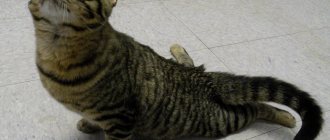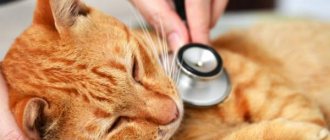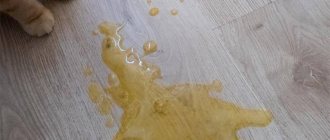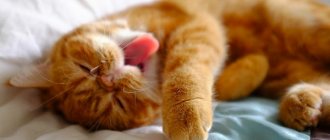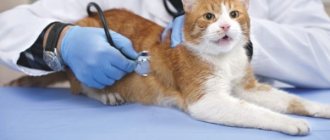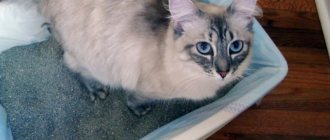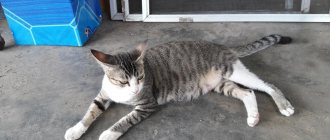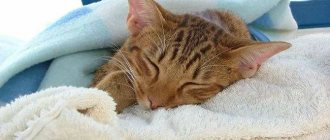Stool color and consistency in a healthy animal
The appearance of feces allows you to assess the health of a cat, cat or kitten. Normally, feces should be:
- dark brown;
- well formed (into a sausage);
- dense;
- wet.
Feces have a specific, mild odor. If the stool smells strongly, this also indicates problems with digestion.
In animals that eat primarily meat, the color of their stool is deep brown. When your pet's diet is dominated by dairy products, the feces will turn light brown or yellow.
If a cat, cat or kitten has white stool, this indicates the development of the disease. The owner needs to observe the animal for several days. If the stool continues to be an unnatural color, you need to reconsider your pet's diet or consult a veterinarian.
What does it mean if a cat has white stool? The cat has white stools and lethargy
Naturally, each case should be considered individually, because many factors can simultaneously have a direct impact on a cat’s stool, which are not always easy to establish without special tests.
We recommend reading: Animal Cat Always Yells
The first thing you should do if you suddenly notice a cat has white stool is to try to remember what he ate the day before, because there is a whole group of products that can affect the bowel movement of animals in such a somewhat unusual at first glance way. In fact, everything has a fairly simple explanation and white feces in a cat can easily be caused by an insufficient amount of enzymes, as a result of which individual ingredients (mainly proteins of animal origin) are not completely digested or, in general, pass through the pet’s intestines. For example, a situation where a cat has white stools most often occurs after eating too fatty dense cottage cheese, white meat and fish. Some types of chicken by-products, and in particular necks, are especially difficult to digest.
Interesting situations also occur with combined feeding, when a pet’s stool can be fragmented not only in consistency, but also in color (partially whitish, partially dark brown with clearly defined boundaries). So, this can be explained by the fact that on the same day the fluffy purr ate dry granulated food and natural proteins (dairy, meat or fish products, etc.). In principle, there is nothing terrible or pathological in this, and if the owner no longer wants to observe such external manifestations in his ward, it is enough to simply reconsider his daily diet.
Another fairly common reason why a cat may have white feces is an imbalance in the protein-carbohydrate balance in their body. Such changes are often observed when a pet regularly receives improperly balanced food and its menu is dominated by carbohydrates, while the entire emphasis should be placed on proteins (proteins of animal origin).
Meanwhile, we should not forget that a cat by nature is a predator and even the fluffiest and most harmless purr is in dire need of meat, so you should not deprive it of such a simple pleasure, because it really is of enormous importance for the normal development of the pet.
That is why an abundance of grain crops, as well as vegetable soups, are not included in the normal diet for cats, although, of course, some types of cereals should still be present in it. For example, almost all cats are recommended to be given rice regularly, even in small quantities. Also, for those pets who suffer from chronic constipation, a significant increase in the volume of ingredients containing easily digestible fiber of plant origin (vegetable stews and soups) is provided. At the same time, the presence of animal proteins in the daily menu must, if not be maintained at the same level, then be reduced in small quantities, mainly by increasing the consumption of carbohydrate-containing ingredients.
If, as a result of such an updated diet, the owner suddenly notices that the cat has white feces, but he is still alert and active, then it is advisable to again amend the menu, continuing experiments until the animal’s stool is completely normalized. Things will be completely different if, in parallel with a change in the color of the stool, other negative symptoms are observed, be it lack of appetite, apathy or, on the contrary, unjustified aggression and irritability, lethargy, drowsiness, as well as an increase in general body temperature.
In this case, there is no point in being idle, waiting for everything to work out on its own, because it is more likely to say that the problem is not in the diet at all, but in the functioning of the pet’s internal organs. So, it is quite possible that the liver or gall bladder has suffered a serious malfunction, which most often occurs when there is an excessive concentration of bile or its obstruction into the duodenum. In the latter case, you should additionally observe your pet’s urine, because if it has changed color, then the above assumption is indeed justified.
In addition, it is necessary to pay attention not only to the fact that the cat’s feces are white, but also to its various impurities and inclusions. The fact is that if a cat's white stool contains mucus or blood, then the problems can be much more serious, affecting the entire digestive system of the pet as a whole.
So, if you notice white feces in a cat with all the side symptoms described above, you should immediately show it to a specialist who will examine and palpate the liver, and also prescribe an ultrasound of the internal organs and a biochemical blood test.
In this case, there is no point in being idle, waiting for everything to work out on its own, because it is more likely to say that the problem is not in the diet at all, but in the functioning of the pet’s internal organs. So, it is quite possible that the liver or gall bladder has suffered a serious malfunction, which most often occurs when there is an excessive concentration of bile or its obstruction into the duodenum. In the latter case, you should additionally observe your pet’s urine, because if it has changed color, then the above assumption is indeed justified.
Causes of changes in stool color
White or light-colored cat feces warns of the possible presence of a dangerous pathology in the animal’s body. At the same time, the frequency and nature of bowel movements may change.
In the small intestine, feces are colored brown by bile. If the secretion of this physiological fluid is impaired, then the stool is light in color.
Veterinarians identify the following causes of white stool in cats:
- Cholelithiasis. It is a consequence of feeding your pet low-quality, cheap food. Along with it, urolithiasis is often detected. The bile ducts become clogged with sand and stones. Bile continues to be produced, but cannot leave the gallbladder. This can lead not only to digestive disorders, but also to organ rupture.
- Neoplasms in the liver, gall bladder and ducts. Cysts, benign or malignant tumors often cause disruption of the outflow of bile.
- Cirrhosis. Liver cells begin to degenerate. The pathological process is irreversible. With the help of timely therapy, you can prolong and make your pet’s life easier.
- Atony of the gallbladder. The walls of the organ are weak, stretched and soft. They do not contract and do not push bile into the ducts. This may result in organ rupture.
- Deformation of the ducts. The pathology can be congenital and affect the appearance of stool.
- Inflammatory processes in the liver. Most often they are observed with hepatitis and cholangitis.
If the animal has white feces only once, the reason may be due to diet. This happens when there is an excess of phosphorus in the body. Light-colored feces are normal after a pet has eaten a lot of fish (especially river fish). However, the owner must understand that this type of diet is unacceptable for an obligate predator.
Causes
Normally, cat feces are dark brown in color. Changes in the color and consistency of feces indicate improper functioning of the digestive system or some organ . Light-colored feces in a cat often indicate problems with the liver, or more precisely, with the gall bladder . The fact is that bile turns feces brown. When food enters the small intestine, a catalyst is needed for its complete digestion, which is bile. If there is not enough bile, its consistency is changed or disturbed, food is not digested as it should be, and accordingly, bowel movements look abnormal.
White stool in a cat is a sign of illness . It is important to understand that the outcome of treatment may depend on your efficiency and attentiveness. The lack of bile in the intestines is not only a symptom, but also a guarantee that the cat will not digest food properly. As you know, it is from the small intestine that the body takes the main amount of nutrients and vitamins. You need to see a doctor even if the feces seem just light (not white). Colorless feces are often dry, which leads to intestinal injury. As a result, the owner observes mucous diarrhea with blood, but as you understand, this is a consequence, not a cause.
The speed of the owner's response plays a very important role, since almost all the root causes that led to stagnation of bile are very serious. Having discovered that the cat’s feces have turned white, you need to establish strict observation for 1-2 days. Your task is to understand whether your pet eats and if the answer is yes, then whether he has a sharp reaction to high-fat food. You need to monitor the amount of water consumed and the frequency of stool. During bowel movements, the cat should not strain, and if you observe this, you need to check the moisture content of the stool. Dryness may indicate improper feeding or dehydration.
Important! Bones and their fragments consumed by a cat often result in a loss of color in the feces. Based on the experience of owners who actively discuss the health of their pets on forums, it has been established that the consumption of bones leads to constipation, problems with the liver and digestion of food.
Try to analyze your pet’s behavior, observe its mood and well-being. When a cat doesn't feel well, it becomes lethargic or irritable. If such changes are observed, you need to tell your veterinarian. The fact is that during the examination they try not to prescribe medications to cats, but if the animal is in pain, then this rule is not entirely relevant. Gallbladder problems may be obvious if you pay attention to the right things. When your cat is unable to digest certain foods, you will see a decrease in appetite and weight loss . Aversion to junk food is a reflex to which the cat obeys unquestioningly.
Under certain events, a small amount of bile and, accordingly, a decrease in its outflow can be considered normal. When dehydrated, all available moisture is used to form blood and protect mucous membranes. After suffering stress, treatment, poisoning, heat stroke and other conditions that adversely affect the liver, a decrease in the activity of the gallbladder is also predictable.
The owner should not treat the cat themselves , but a detailed history will never harm the diagnosis. Write down all your observations and assumptions, even if they seem insignificant to you.
When you consult a doctor, he will be faced with the difficult task of selecting only one diagnosis from the list of possible ones:
- Cysts, malignant and benign formations in the liver, gall bladder and ducts can be diagnosed in animals of any age. Any neoplasm disrupts the natural shape of the organ, and therefore its functioning. The doctor also needs to rule out fibrosis, that is, the process when liver cells degenerate into something like a sponge.
- Cholelithiasis is more often found in adult cats whose diet is formulated without taking into account their needs. Keeping an animal on cheap (a priori low-quality) dry food will sooner or later result in not only cholelithiasis, but also urolithiasis. If there are stones or sand in the gallbladder, the outflow of bile physically stops. Against this background, with every meal, bile continues to be produced. Considering that the gallbladder is not dimensionless, and bile (especially concentrated) can eat away not only food, perforation (rupture) of the walls of the organ can be fatal.
- Atony of the gallbladder - bile is pushed out through the ducts under pressure. With atony, the tissues become soft, do not contract, are greatly stretched and thinned. As a rule, if the animal is not helped, atony of the bladder leads to severe intoxication and rupture of the walls of the organ.
- Hepatitis and cholangitis are an inflammatory process in the liver, gallbladder or ducts. In this case, diagnosis and treatment vary greatly, it all depends on the severity of the condition, age, general condition of the cat and the severity of the disease.
- Cirrhosis is not a condition, but a constantly progressive disease that leads to irreversible degeneration of liver cells. As you know, liver cells are restored, but with cirrhosis, the process of degeneration occurs much faster. The pathology is incurable, but its development can sometimes be controlled with medication.
- Deformation of the gallbladder ducts is a disease found in both adult and very young cats. White feces in a kitten, provided that it eats normally and receives parasite prevention, most often indicates pathologies in the development of the gallbladder or ducts.
Treatment and prevention
The therapeutic course depends on the cause of the change in the color of feces. If an alarming symptom is detected, it is necessary to show the animal to a doctor. To make a diagnosis, the veterinarian will comprehensively examine the cat.
Diagnostics includes:
- external examination of the pet;
- taking blood, stool and urine tests;
- performing an ultrasound, MRI or CT scan of the abdominal organs;
- radiography;
- biopsy of pathologically changed tissues.
The doctor decides what to do and how to treat the animal.
If there are neoplasms, stones in the gall bladder or rupture of an organ, the animal undergoes urgent surgery. If sand is present, a therapeutic diet and diuretics are prescribed.
To eliminate inflammation, the veterinarian prescribes antibiotics, antiviral and anti-inflammatory drugs, as well as immunomodulators for the pet.
It is important that the animal consumes plenty of fluids throughout treatment.
The owner’s task is to provide proper maintenance and care. Particular attention should be paid to nutrition. The diet is prescribed by the doctor. The diet should consist of medicinal feed or natural products (fresh meat, liver, stomachs, lungs, vegetables, a small amount of cereals). The pet should not be fed human food (fried meat, sausages, fish, soup, borscht, etc.).
Treatment and prevention of pathologies of the liver, pancreas and gall bladder are closely related. To avoid relapses, your pet must be regularly brought for veterinary examination, given all vaccinations and provided with a balanced diet (high-quality industrial feed or natural products).
Treatment
The key to successful treatment is a complete diet that takes into account the individual needs and condition of the cat. Please note that there can be no talk of cheap food or natural feeding “whatever is necessary”. Even if the cat feels well, small amounts of fatty, spicy, pickled, smoked or other junk food can dramatically worsen its health.
During diagnosis and treatment, the amount of water consumed is strictly controlled . When a cat is dehydrated, bile is not produced or not enough is produced. When too much water is consumed (for a number of alarming reasons), bile loses concentration, leading to incomplete digestion of food. In the second case, the animal loses weight and suffers from vitamin deficiency.
If formed stones or a tumor that is compressing the liver is detected, there is only one way out - surgery. In all other cases, treatment is selected individually. If there is sand in the gallbladder, the cat is prescribed a therapeutic diet and choleretic drugs. Dissolving sand is a long process, but it does not require rough intervention.
Detected inflammation indicates that the body is affected by bacteria or a virus. Both cases require individual treatment, in the first, antibiotic therapy, in the second, immunostimulants, antiviral drugs and intensive supportive care.
Liver cells have the ability to recover, but this process occurs slowly. For fibrotic liver damage, restraining but gentle therapy is used. Cirrhosis is one of the most serious liver pathologies; it can progress quickly and, unfortunately, there is no effective treatment for it. With cirrhosis, the cat’s body is supported by stimulating cell division, but if the damage process occurs faster than recovery, the animal is doomed.
White feces in a cat: reasons, what to do
In cats, the color of feces is determined by bile, which flows from the gallbladder into the lumen of the duodenum in a certain amount. This happens when the animal is healthy. Normally, cat feces are dark brown in color, and most pathologies of the gastrointestinal tract associated with the flow of bile into the small intestine can be determined by changes in their shade. White feces in a cat is an alarming sign, which should be a reason for increased attention to the health of your mustachioed pet and an incentive to consult a veterinarian.
What might the stool of a sick animal look like?
In the tray of his pet, the owner may find feces that differ in shape:
- ointment-like;
- mushy;
- liquid;
- foamy;
- in the form of “goat peas”;
- in the form of a tape or pencil.
By smell they distinguish: sour, rancid, putrefactive.
- Feces acquire a sour smell when the absorption of fatty acids in the small intestine is disrupted or due to fermentation processes in the large intestine.
- An unpleasant odor, similar to the smell of bad oil, occurs when the secretory function of the pancreas is disrupted or when the flow of bile is disrupted.
- The smell of rotting occurs when digestion in the stomach is disrupted, dyspepsia develops with the proliferation of putrefactive microflora in the intestines. Or the cat suffers from colitis with ulcerations.
It is customary to distinguish feces by color:
- red (beetroot);
- black (tarry);
- dark brown;
- light brown;
- with a scarlet admixture (undigested blood);
- yellow;
- light yellow;
- greenish yellow;
- bleached slightly yellow, gray, gray-white.
A healthy cat can have red or beetroot feces if it has eaten beets or food colored with bright dyes. This coloring is not pathological and soon the stool acquires a normal color.
The influence of nutrition on the color of excrement
In veterinary medicine, white feces are called acholic. Literally, this means “lack of bile” (Greek: chole - bile, a - without). But white feces do not always indicate serious health problems. This is always considered a pathology, but sometimes the condition is reversible in the shortest periods of time only with the help of nutritional correction.
White feces in a cat can be due to:
- feeding with bones (liver function is disrupted);
- states of dehydration (in addition to the color, the stool becomes dense and “free-flowing”);
- improper dosing or long-term use of medications that affect the gastrointestinal tract and liver system (antibiotics, sorbents);
- feeding excessively fatty foods (not always and not for everyone, but often);
- digestive disorders due to stress;
- too much dairy products (stool becomes light yellow, sometimes turning white, due to indigestion due to fermentation in the intestines).
Usually, after eliminating the above reasons, the color of stool returns to normal.
When colorless stool is a cause for concern
Sometimes a cat's white feces can be due to more serious health reasons than poor diet. In most cases, these are deviations in the functioning of the biliary tract and the liver as a whole:
- any metabolic disorders and/or inflammatory processes in the liver (hepatosis, hepatitis);
- pancreatic enzymatic insufficiency;
- blockage or deformation of the bile ducts or gallbladder (most often due to cholelithiasis, compression of organs, torsions, adhesions);
- purulent abscess or cysts;
- cirrhosis of the liver (when there is not enough bile initially produced in the liver);
- cholangitis, cholangiohepatitis - inflammation of the bile ducts, gallbladder, or all at once;
- some renal pathologies, in which toxic products accumulate in the blood, which then affect the functioning of the liver;
- any tumor growths in the liver or biliary system that prevent the release of bile into the intestines;
- atony of the gallbladder (lack of contractions).
What else can accompany white feces?
Any deviations in the color of feces and their consistency indicate dysfunction of the gastrointestinal tract and bile-hepatic system:
- Feces with a white coating, especially if it has a loose consistency, may indicate an excess of stringy meat products and bones in the diet.
- White feces with a liquid consistency are usually observed with liver pathologies, pancreatic enzyme deficiency, and irritable bowel syndrome.
- White-cloudy mucus indicates diseases of the large intestine. Also, such a symptom can be observed when infected with helminths - in such cases, white worms can be found in the feces.
- If white grains are found in the stool, the cat should be checked for worms, fungi of the genus Candida in the digestive tract, and the stool should be tested for digestion. White spots in the stool may be undigested food debris. Sometimes white spots can develop into small white worms - a clear sign of helminthic infestation.
Causes of light-colored stool in pregnant women and children
Before a child can be born, it must be conceived and then carried to term. So let's start with pregnant women first and then move on to children.
In pregnant women, gray feces can be observed due to the consumption of large amounts of fruits and all kinds of vitamin complexes. A child needs a lot of vitamins. If this is not accompanied by abdominal pain and other types of ailments, then most likely there is no cause for concern. When changing the diet, the color of feces should normalize. But it is better to consult a doctor.
Newborn babies may also experience abnormal stool color. Infants' poop may contain white specks. These inclusions are nothing more than lumps of fat from the mother's breast milk. Also, when fed heavily with formula milk, baby shit can take on a light color. Diet adjustments are necessary to normalize the color of the newborn's stool. But do not lose your vigilance, carefully monitor your child’s behavior and possible changes in mood; perhaps something hurts him. In this case, the cause of light-colored poop is no longer food, but something else. In any case, it is better to play it safe and consult your pediatrician.
So the couple came to take stock. Know that you need to regularly check what you got there when you go to the toilet for the most part. What if there is a message or distress signal there for you? In some cases, changes noticed in time will play a significant role in treatment. Be attentive to all changes in your body; it has its own alphabet to communicate with you, and sometimes its letters are poop.
And remember, a site about poop will always be happy to help you in any life situation. We wish you healthy feces and excellent digestion and appetite!
Relief!
What should a cat owner do first?
White feces in a cat - what to do? Doing anything on your own in terms of medication intervention is highly not recommended. You only need:
- over the past few days, analyze what and how Murka was fed;
- adjust feeding if nutritional disturbances are detected;
- monitor over the next few days whether there is a change in the color of the stool towards darkening;
- if a change in feeding does not lead to the restoration of the color of the stool, you should visit a veterinarian, preparing as detailed an anamnesis as possible (information about the keeping and feeding of the animal, prior to the lightening of the stool);
- If white worms are found in a cat’s feces, the feces should be submitted for parasitic analysis.
If stool lightening is simultaneously accompanied by refusal to eat, general weakness, apathy or, conversely, anxiety, diarrhea or constipation, as well as changes in body temperature (in any direction), then a visit to the veterinary clinic cannot be postponed!
What to do if worms or their eggs are found in a cat’s feces?
What to do if you find parasites in your pet’s feces or vomit? First of all, don’t panic, all intestinal infections can be treated. However, do not forget about your own safety and infection prevention. First, assess the pet’s condition; if the animal looks weakened, dehydrated, or sick, then self-treatment may worsen the situation.
According to generally accepted recommendations, prevention of worms is not recommended without the supervision of a veterinarian if the cat:
- Pregnant or nursing kittens.
- Under 3 weeks of age or over 12 years of age.
- Sick or recovering from an illness.
- He is undergoing treatment, especially with the use of antibiotics.
- Suffering from exhaustion or chronic pathologies.
Without prior consultation with a veterinarian, it is not recommended to carry out worm prevention if the animal’s medical history is unknown or the period of infestation is more than six months.
The problem is that a large number of parasites that die at once provoke severe intoxication. When dying, the worms secrete a lot of mucus, which is a foreign protein, to which the body responds with an allergic reaction, fever and typical symptoms of poisoning.
Important! In kittens and young animals, the immediate destruction of worms during a critical infestation can lead to clumping of dead parasites, intestinal blockage and even perforation.
Treatment by a veterinarian
Cat owners should immediately realize that it is not white feces, as such, that are being treated, but the cause that led to this condition is being eliminated. The speed of restoration of the color of feces will depend on the severity of the condition and the general condition of the cat’s body at the time of contacting the veterinary clinic. Sometimes it is possible to restore the color of stool within a few days, sometimes treatment will take longer. There are rare cases when the condition may be irreversible (liver block, oncology).
A correct diagnosis can be made based on:
- clinical examination;
- blood tests (biochemistry and general);
- urine and feces examinations;
- Ultrasound;
- x-ray;
- biopsy (usually taken from the liver, but performed quite rarely).
Any therapy will be meaningless without normalizing the cat’s diet or transferring the cat to a special diet recommended by the veterinarian, according to its state of health.
What treatment is used (schedules and course durations are developed only by veterinarians with individual dosage selection):
- hepatoprotectors that normalize liver functions and metabolic processes (thiotriazolin, Essentiale, Hepatovet, Hepatoject);
- choleretic drugs (ursosan, allohol, cholenzyme);
- relieving spasms and biliary-hepatic colic (buscopan, baralgin, papaverine, mebeverine).
No-shpa is highly not recommended for cats due to the high risk of developing unwanted side effects;
Diagnostics
If the owner has noticed that his cat has pooped more than once with feces that are significantly different in color, smell and consistency from the norm, it is necessary to find out the causes of this pathological condition as soon as possible, so a visit to the veterinarian and a comprehensive diagnosis is indispensable. At the first appointment, the doctor will examine the pet, ask the owner what symptoms are bothering his pet and how long the problems with bowel movements have been observed. If it is not possible to immediately establish an accurate diagnosis, a referral is given to such additional research methods as:
- general clinical analysis of blood and urine;
- fecal analysis for the presence of worms, as well as blood, mucous and other inclusions;
- biochemistry;
- Ultrasound of the abdominal organs.
Return to contents
White feces - causes and consequences
A change in the appearance, color and consistency of feces is a malfunction of the pet’s internal organs. Light and white color of feces indicates a pathology of the cat's pancreas, gallbladder or liver. White feces are a pathology; normally, feces are brown in color. This occurs due to bile secreted in the small intestine. If this natural process is disrupted, then the shade of the stool becomes different - lighter, and sometimes even completely white. At the same time, the nature and frequency of bowel movements changes.
Bile deficiency in the intestines leads to disruption of the normal course of digestion, which has a detrimental effect on the health and condition of the animal as a whole.
If a cat has white stool, this is always a sign of illness. Often white feces in cats are accompanied by other serious symptoms: diarrhea, mucus, constipation, and bloody feces. Stagnation of bile in an animal’s body can lead to deep intoxication and even death of the animal. Without proper therapy, the prognosis can be disappointing. To cure a pet, the owner needs to act quickly and competently.
What do adult worms look like (dead and alive)
According to generally accepted rules, a cat must be treated for worms quarterly. The logic here is as follows - you cannot protect your cat from becoming infected with parasites, but you can control their numbers. Within 3–4 months, the invasion becomes noticeable, the worms become adults and the animal’s body begins to suffer from them.
Remember! By carrying out prevention regularly, you reduce peak infestation to a minimum and interrupt the reproduction cycles of most types of worms.
What happens if worm prevention has not been carried out for six months or more? Worms multiply and occupy the intestinal lumen, which will lead to irritation and inflammation.
Irritation of the intestinal walls leads to:
- Nausea and vomiting.
- Diarrhea with a lot of mucus.
Note! If the infestation is severe, diarrhea may alternate with constipation as the worms physically block the intestinal lumen.
Along with vomit and feces, worms (dead or alive) may begin to come out of the cat’s body. If the worm dies, its body may be partially digested - it looks like a white thread covered in transparent mucus.
Roundworms most often live in the cat’s intestines; they can be distinguished by the following characteristics:
- Color white or cream.
- Length up to 14–15 cm.
- The ends of the body are rounded.
- Live worms squirm briskly.
- When exposed to an oxygen environment, they produce a lot of mucus.
In rare cases, so-called flukes may be found in the stool. These parasites are smaller and thinner than roundworms and have a pinkish color. Again, in rare cases, usually after prevention of worms, large worms consisting of several oval segments may be found in the feces - these are tapeworms, most likely a cucumber tapeworm.
Light-colored stool - observation and diagnosis
White and light-colored feces in cats require a quick response, and the animal’s vital activity should be monitored.
- What kind of food does the cat have, does it ask for water.
- How much does a cat eat and drink per day?
- How many times does the cat visit the litter box, what is the nature of its bowel movements?
- Features of cat behavior during defecation.
Two or three days of observing the animal and passing the necessary tests will help the veterinarian determine the cause of the change in feces, and therefore establish the correct diagnosis and prescribe the correct treatment.
List of tests recommended by your veterinarian when your cat has white stool:
- general blood analysis;
- blood for biochemistry;
- analysis of feces and urine;
- ultrasound of internal organs;
- X-ray;
- biopsy.
Testing the animal's blood and feces will allow the specialist to assess the animal's overall health. Special laboratory tests will tell you which organ the pet has problems with. Ultrasound examination helps to identify neoplasms, displays pathological degeneration of healthy tissues, and shows stones and sand in the ducts.
How to avoid getting worms from your pet?
How to avoid getting worms from a cat? Basic hygiene rules will help protect yourself and your family members. Be sure to wash your hands after handling an infected animal. To feed your pet, you must use separate dishes; if there are children in the house, clearly explain to them that the cat cannot be treated from your plate.
Worm eggs can be spread through saliva, feces and vomit. Until the animal has completed the full course of treatment, avoid close contact. Make a habit of wearing gloves when cleaning the litter box and washing your hands thoroughly afterwards. If you use sand to fill the tray, it must be refreshed once every 3–7 days.
The most reliable way to protect yourself is regular prevention. It is important to understand that you are much more likely to “catch” parasites if you are in public places and transport. Not only the four-legged dog, but also all family members should receive anthelmintic drugs. Prevention for people, according to general recommendations, is carried out once every six months (in spring and autumn).
How to cure a pet
Diseases that reduce the activity of the gallbladder and cause light-colored stools and white feces in cats:
- Blockage of the gallbladder ducts, resulting in disruption of the normal flow of bile.
- Neoplasms in the internal organs of the animal - liver, gall bladder and pancreas. They disrupt the natural shape of the organ, impairing its function.
- Gallstone disease, often associated with the age and diet of the cat. Dry low-quality feed leads to the development of urolithiasis and cholelithiasis in animals.
- Liver cirrhosis is a pathology that leads to cell degeneration. Restoring lost liver cells is impossible; medications are needed to maintain the body and curb the progression of the pathological process.
- Hepatitis of the liver, pancreas and gall bladder. These diseases require special diagnostics and antibiotic treatment.
- Atony of the gallbladder without special treatment can lead to rupture of the organ and sudden death of the cat. The disease is associated with severe intoxication, stretching and softening of the gallbladder tissue.
- Oncological diseases of the intestine in the early stages can also be accompanied by stool of an unnatural light color.
Other animal conditions that may result in white feces:
- Dry, light-colored feces in cats indicate poor nutrition and dehydration of the animal's body. A healthy diet and adequate drinking will help your pet recover quickly.
- The cat's poop has turned white! The owner should be more attentive to the pet's nutrition. Bones and bone fragments in the diet lead to constipation and discoloration of stool.
- White poop in a cat, combined with nervous and irritable behavior, sudden loss of body weight, and absolute refusal of food and water, is a signal of liver disease.
- White feces can be the result of severe stress, poisoning, heat stroke, dehydration, blood loss and other reasons related to the function of bile-forming organs.
- Part of the stool is white-greenish in color - the reason for this condition lies in infection. Treatment requires the use of certain antibiotics, followed by the prevention of dysbacteriosis and a course of vitamins.
The regimen and method of treatment depend on the identified pathology and the stage of its development. The success of therapy largely depends on high-quality nutrition and living conditions for the cat during recovery and in the future. With chronic diseases of internal organs, many cats are prescribed lifelong dietary nutrition.
Signs of worms in kittens
Cats, like people, are at risk of various diseases. If you have a four-legged friend in your home, you should be attentive to his health: you can understand that an animal is sick only by certain symptoms, which are not always pronounced. For example, signs of worms in kittens may not appear at first, but the disease may already be destroying your pet’s body from the inside and, moreover, poses a danger to humans. So, today we will talk about the symptoms of worms in a cat, as well as methods of their treatment and prevention.
Where do worms live in a cat's body?
Signs of the disease when parasitized by one or another type of worm in cats are largely determined by the location of the infestation. And there are quite a lot of these places in the body. Worms can settle and subsequently destroy the balance of a living system in almost any organ. They can be found in: intestines; stomach; liver; lungs; kidneys; bladder; and even in the heart or eyes.
Mostly felines are affected by: intestinal parasites – roundworms (ascariasis, toxacorosis); liver - flukes (opisthorchiasis).
In rare cases, helminths can be found in organs and tissues of the host that are unusual for their biology, then they speak of “perverted localization.” With this form of the disease, the parasitic worm for the most part cannot complete the full course of development, but the body still experiences some signs of discomfort.
Our readers successfully use Intoxic to get rid of parasites. Seeing how popular this product is, we decided to bring it to your attention. Read more here...
In addition, there is a so-called transit localization, when larvae or eggs pass through the cat’s body without stopping anywhere and without having any negative impact on health.
How to know for sure if a cat has worms
Fragments or whole worms may be present in the feces or on the fur around the anus. The animal “rides” on its butt. The general condition worsens, the appetite changes, and hair loss is observed. There may be alternating diarrhea and constipation, vomiting. Symptoms of worm infestation are often similar to those of other diseases, so you should consult a veterinarian for an accurate diagnosis.
It must be delivered to the laboratory no later than 12 hours after defecation in a glass or plastic jar and stored in the refrigerator until examination. But a single negative test result does not 100% exclude the presence of helminths, since they or their eggs may not get into the sample you took.
Types of worms in cats
Tapeworms (cestodes)
Long and flat, they can reach a length of up to 70 cm. The body of these worms consists of many segments, in each of which larvae mature.
When the larvae mature, they separate and come out together with the feces, while the segmented body of the parasite grows continuously and new segments with larvae appear to replace the separated segments.
It is very common to see tapeworm segments around the anus of a sick animal - these segments resemble grains of rice or sesame. Also, individual parts of cestodes are found on the animal’s bedding. In a more severe form of worm infestation, parasites can be seen in the vomit. Signs of tapeworm infestation:
- changes in the pet’s body weight (the weight either increases sharply, or the cat, on the contrary, rapidly loses weight);
- change in appetite (the cat is insatiable or, on the contrary, refuses food);
- large, “inflated” belly;
- hair loss;
- Excessive licking in the anal area.
Roundworms
Roundworms are the most common type of helminth in cats. There are quite a lot of them, but the most common among our pets are roundworms. In appearance, the parasites resemble spaghetti, which is where the name “round” comes from. The length of roundworms usually reaches 5 cm, but longer individuals are also found.
Kittens can become infected with roundworms through their mother's milk. The danger of infection lies in wait for an adult cat when eating rodents, raw meat and in contact with an infected animal.
Signs of roundworm infection: weight loss; abdominal enlargement; vomit; diarrhea; weakness.
Nematodes
Nematodes are small, white, thread-like worms measuring up to 2 cm in length. Parasites feed on the blood of their host, attaching themselves to the wall of the small intestine. They are less common in cats than other worms, but pose a mortal danger to the health of the pet.
Infection with nematodes can occur when a cat comes into contact with the feces of a sick animal, as well as through contact with particles of soil contaminated with worm larvae.
Symptoms of nematode infestation: weight loss; diarrhea; anemia; rashes and wounds on the skin, especially on the paws, are traces of the migration of worms; darkening or blackness of the cat's feces, the presence of blood in the animal's stool.
Causes of worms in cats
Helminths can affect both street and domestic pets. The larvae of parasites enter the animal's body through food or are carried into the house on shoes. The causes of worms in cats, depending on the type of parasite, are as follows:
- the presence of ectoparasites (fleas, lice eaters);
- consumption of raw meat products, river or sea fish. Most often, cysts are found in raw river fish;
- contact with infected animals;
- intrauterine infection from an infected cat.
In raw meat, even after freezing and thorough washing, parasite cysts can be found.
They are especially common in almost all types of river fish, since it is in their body that the process of ripening of the larvae takes place.
In addition, fish contains a large amount of phosphorus, and as a result of oversaturation of the body with this element, metabolism can be disrupted, so it is best to exclude river fish from the cat’s diet.
Symptoms of helminthic infestation in cats
Symptoms of worms in cats can have a different nature and degree of manifestation depending on the degree of damage and the presence of a particular type of parasitic worm in the body.
In the initial stages of infection, symptoms of worms in cats may not appear or be mild. What are the most common symptoms of worms in cats?
- digestive and gastrointestinal disorders (vomiting, constipation, which are followed by diarrhea, refusal to feed, or vice versa, increased appetite);
- Coughing attacks may periodically occur, especially as a result of infection with roundworms;
- yellowness of the mucous membranes, enlarged liver;
- signs of anemia, which are especially pronounced in kittens;
- tousled, faded fur. Hair loss;
- itching in the anal area;
- small rash, hair loss near the anus;
- severe purulent or severe discharge from the eyes or nose;
- presence of blood masses in feces;
- in severe cases, signs of intoxication are diagnosed. Paralysis of the hind limbs may also develop;
- premature birth or abortion;
- significant enlargement of the abdomen;
- developmental delay in kittens.
It should be noted that signs of helminthic infestation may resemble symptoms of viral or infectious diseases.
If deworming is carried out at the same time, the general condition of the animal can worsen, which in especially severe cases can lead to death.
White feces in a cat - 6 possible causes of problems with stool in a pet
If white feces are observed in a cat, this may indicate hepatitis of various etiologies, cholecystitis, cholelithiasis, infection with worms, and malignant neoplasms. The condition may be accompanied by jaundice, vomiting, fever, increased thirst and dangerous death of the animal. At the first symptoms, the owner should contact a veterinarian, who will diagnose the cat and prescribe treatment.
According to veterinarian statistics, 30% of diseases are liver pathologies, and the formation of stones in the bile ducts in cats is diagnosed 4 times more often than in cats.
What to do for prevention?
Liquid or dry feces, which are constantly observed in a pet, in any case, are evidence of some kind of internal progressive disorder. To prevent consequences dangerous to the cat’s health and life, it is important to follow preventive rules. First of all, it is important to monitor the cat’s nutrition and provide it with fresh and clean water. Do not forget to carry out preventive anthelmintic treatment.
If viral infectious diseases develop, do not self-medicate, but take the animal to a veterinarian, who, based on the diagnostic results, will select an effective treatment. In order for the cat’s body to more actively resist various diseases, it is useful to strengthen the pet’s immunity. To do this, it is recommended to give courses of vitamins and various biologically active supplements, which are selected by the veterinarian, taking into account the individual characteristics of the cat.
Reasons why stool becomes lighter
Hepatitis of various etiologies
Normally, the color of a cat's stool is brown, formed, and moderately dense. When the liver and biliary tract become inflamed, the flow of bile is disrupted, which is why the cat has white feces. Hepatitis is non-infectious when an animal comes into contact with pesticides for a long time or accidentally ingests poisonous plants. Infectious inflammation is caused by bacteria and viruses. Symptoms:
- temperature increase;
- darkening of urine;
- yellowness of the mucous membranes and eye sclera;
- increased thirst;
- diarrhea or constipation (stool is excreted in round, dense grains);
- weight loss;
- heart rhythm disturbance.
Return to contents
Cholecystitis
With this disease, the gallbladder becomes inflamed, which leads to stagnation and decreased flow of bile. The cause of the disease is poor-quality or expired food, abdominal injuries, irregular nutrition, metabolic disorders, severe infectious diseases, and worms. In addition to the fact that the cat’s stool becomes gray or whitish, the following signs are observed:
- jaundice;
- frequent vomiting;
- loss of appetite;
- lethargy, refusal to play;
- dry mucous membranes;
- increased need for water;
- dull, patchy fur.
Return to contents
Cholelithiasis
Cholelithiasis is characterized by the formation of stones in the intrahepatic and biliary tracts and bladder that block the ducts. Most often it develops against the background of liver pathologies, as well as due to metabolic disorders of cholesterol, phospholipids, bilirubin, bile acids and pigments. This promotes the formation of thick bile and cholesterol crystals in it, which later become denser, forming stones. Symptoms:
The presence of stones in the gall bladder causes the pet to lose a lot of weight.
- jaundice;
- vomit;
- dehydration;
- decreased heart rate;
- abdominal pain;
- weight loss;
- white stool;
- skin itching.
Return to contents
Worm infestation
If a cat poops white feces, it may be liver damage from helminths such as fluke, roundworm, toxocara, cucumber tapeworm, hookworm. Worms and their eggs clog the bile ducts, disrupting the flow of bile. Parasites enter a cat's body by eating raw fish or meat, grass, drinking contaminated water, or licking its paws after a walk. Manifestation:
- stool is white or gray;
- vomit;
- itching in the anus, the cat “rides” on its butt;
- hair loss;
- skin rashes and redness;
- deterioration of wool structure;
- liver enlargement;
- yellowness of the sclera and mucous membranes;
- abdominal pain;
- refusal of food;
- stool instability.
Return to contents
Cancer tumor
A cat is diagnosed with sarcoma or carcinoma, which metastasizes and has a rapid progression. The formation of a tumor in the liver and bile ducts is most often secondary, occurring against the background of a lesion in the body. In addition to the light shade, there is a bloody admixture in the stool. In the initial stages, the disease is asymptomatic, then the following symptoms appear:
- vomit;
- increased thirst;
- sudden weight loss;
- anemia due to internal bleeding;
- diarrhea;
- yellowness of mucous membranes;
- lethargy, lack of vigor;
- frequent urge to urinate.
Return to contents
Causes of light-colored feces in babies
If a kitten has white stool, this may indicate a lack of enzymes secreted by the pancreas. Yellow feces occur if only milk is present in the baby’s diet. In older kittens, a deviation in color may indicate dyspepsia and fermentation processes in the gastrointestinal tract.
Is it always possible to see worms in feces?
Contrary to popular belief, this does not happen in all cases. It is relatively common to see more or less large parasitic nematodes. But this only happens in cases where the degree of helminthic infestation is really serious.
Occasionally, dead parasites may emerge from the animal's intestines, but this does not happen often. In addition, the bodies of the worms are usually half dissolved, since after their death the mechanisms that protect the parasite from the action of digestive enzymes are no longer in effect.
Much more often, you can see only a small amount of mucus in the feces. As you can understand, this sign is also difficult to classify as characteristic.
Interestingly, one study of American veterinarians showed that approximately a third (!) of all examined cats had roundworm eggs in their feces. And this is most likely not the limit, since not in all cases worm eggs can be detected in feces.
Some types of cestodes are a different matter. For example, the cucumber tapeworm, which we already mentioned. The fact is that parasitic flatworms have one important feature. Every day small segments, segments, are torn off from their body. The biological meaning of this “procedure” is that each of the fragments is chock full of parasite eggs. They can often be seen in feces. And not only, unfortunately.
What to do if the stool is white?
Therapy is prescribed by a veterinarian, depending on the etiology of the disease; self-medication is prohibited. If a large stone is observed in cholelithiasis, surgery or crushing and removal of the crystals with a laser is performed. When a tumor is diagnosed, surgery should be performed. For hepatitis, hepatoprotectors and antispasmodics are prescribed. You can expel the cat parasite with anthelmintic drugs. If there are a lot of worms, surgical removal is required. Diuretics and choleretic drugs are also used. A diet is prescribed in the form of lean broth, oatmeal with water and vitamin and mineral complexes. Among the feeds, it is recommended to choose holistic or premium brands with the Sensitive mark.
